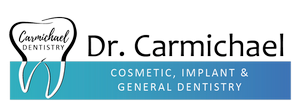Are you curious about dental bridges? You might be wondering what they are and how they work? Well in this blog, here’s dental bridges explained!
A bridge is something that can replace a missing tooth. A bridge is an alternative to a denture OR implant. Usually, with the bridge, it would adhere to a tooth adjacent to the missing gap. We would prepare teeth on either side of a missing tooth, and then you can have a bridge made. You glue the root bridge onto the prepared teeth, and you have a fake tooth in the middle so that it replaces the tooth attached to the teeth on either side. They can treat several gaps in one go. Bridges can be an alternative to removable partial dentures, depending on the number of teeth you have missing, but it would depend on the teeth on either side and their strength. You should come and talk to Dr. Carmichael, have some x-rays taken, and your teeth assessed to see whether this would be an appropriate treatment.
There are fixed bridges (one of the more destructive types of bridges), and there are newer, more modern types of bridges, such as sticky bridges, but it’s probably best you go and see Dr. Carmichael and find out which bridge is appropriate for you.
Dental bridges stay in place via dental cement, so they are glued in place, and they are fixed in position, so they are not removable. Usually, people cannot tell that you have a bridge in place, especially if the tooth color and tooth contour are similar to your own. You can have a bridge straight after a tooth extraction, but it would only be a temporary bridge. After a tooth is extracted, you would find that the socket heals and it recedes so you may need a more permanent bridge afterward. Usually, after an extraction, you could have a temporary denture and then a bridge as a more permanent solution.
During your first visit, your dentist would prepare the teeth and take some impressions to send to the lab. Typically two weeks later, the lab would send back your fixed prosthesis, and you would go back and see the dentist, and they would fix your bridge for you. It’s essential that you still clean and maintain your bridge and the adjacent teeth by flossing underneath the missing tooth.
You would always need to have a dental checkup and have your teeth assessed to see if you’re a good candidate to have a bridge. The pros of having a bridge are that it’s fixed in position, so you don’t have to remove it, and it is quite strong so you can chew on it, and it looks quite natural. The cons of having a bridge are that you may need to prepare adjacent teeth so you may need to damage healthy teeth to take a bridge. Flossing between the bridge can also be tricky and requires you to purchase a bridge floss threader or a waterpik. Depending on which type of bridge you have, it’s best that you go and see Dr. Carmichael to determine which type of bridge is appropriate for you. Sometimes the cement in dental bridges can come loose, and it may come out if you eat something particularly hard or sticky. So save your bridge, and you can go back to the dentist and have it recemented if possible.




